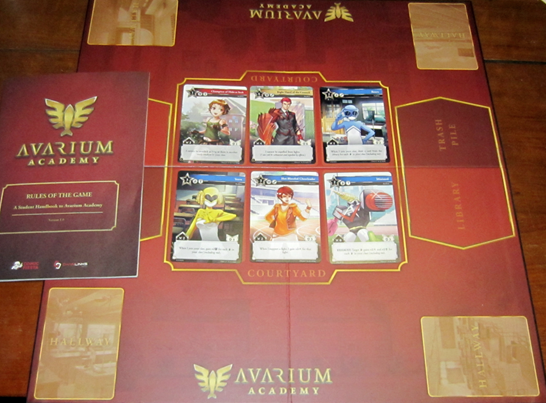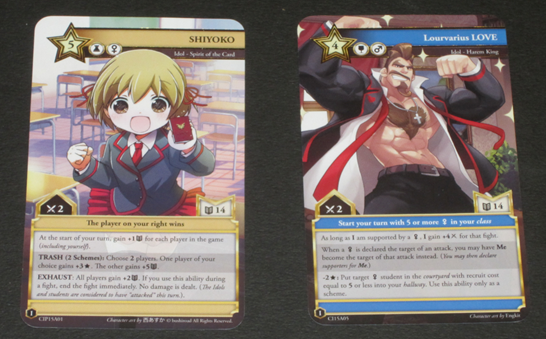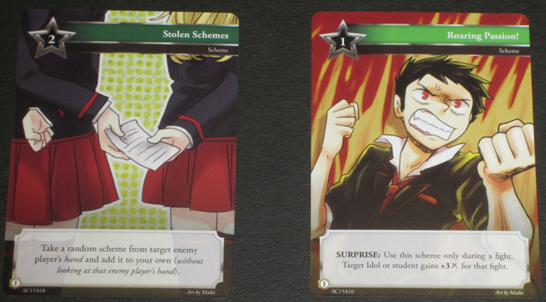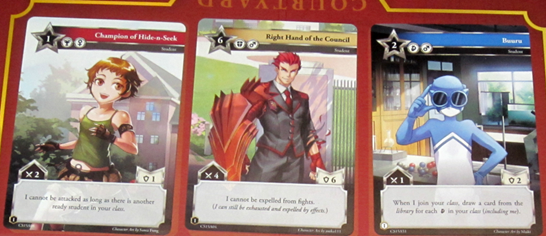Avarium Academy is a board game for 2-4 players by Jared Cheah, although the board is mostly cosmetic. This is primarily a card game. In the game, you attempt to recruit students at a Magical High School to help you become Class President. Of course, your students will frequently fight the opposing students to help you get the presidency (it draws on a lot of anime and manga conventions). I initially thought this game would work better as a CCG, but after playing it I believe the non-collectible format is much superior.
Each player controls one Idol (their main character), who has a special win condition and some special abilities. The idol generates “Reputation”, which can be spent to recruit new students or to pay for effects. A “Courtyard” in the centre of the board holds six students. Players can only recruit new students from the Courtyard, which is refilled as each student leaves it. You don’t have access to the students you recruit until the end of the turn, as they have to spend time waiting in the “Hallway” first.

Apart from recruiting, you can play Scheme cards from hand or have your students or idol attack the opposing classes. An idol cannot be attacked unless all of its classmates are exhausted (or expelled).
Attacking is interesting: Each student has damage and defence values. When a student is damaged, if the damage is equal or greater than its defence, it is expelled (discarded). If the damage is less, it is exhausted. Exhausted students cannot attack nor deal damage, but can be attacked. During attacks, both players can add in extra students to either side, with – in multiplayer games – other players being send in one additional character to support either side. The lead student on each side must take the damage first, with any remaining damage being split amongst the remaining participants as the damage-dealer wishes. In a big brawl, many students may be expelled!

Idols
Damage to idols is handled differently: it reduces that player’s Merit. When a player reaches 0, they have lost the game.
To win the game, you can fulfil the unique win condition of your idol, reduce everyone else’s Merit to 0, or have the highest Merit when the School deck runs out of cards.
Apart from the School deck, which contains 60 Student cards, there is a 40 card Scheme deck, which provide a number of hidden tricks and surprises. You begin with 2 Schemes in hand, and draw one more each turn. Schemes are typically paid for by Reputation, but you could also exhaust one of your students to play one (as long as that Student’s Reputation cost is equal or higher than cost of the Scheme). Some schemes can only be played during the main part of your turn (and not during fights), other schemes are Surprises and can be played at any time.

The interaction between the exhausting of students to pay for abilities and their inability to deal damage when exhausted gives rise to some very interesting play. It can also be devastating if an effect exhausts your student in the middle of combat. Those sorts of surprises are rare, but they do happen. There’s enough variety in schemes and student abilities to make the battles between students tense and interesting. Although there will be games where one player just dominates, there’s enough ways of interfering with your opponent to come back from behind.
Although the game says it’s for 2-4 players, the structure of the game means that it works best as a 2-player duel. Things get messy with more players, and the temptation to “turtle” and not attack becomes much stronger – which benefits a few of the Idol’s unique win conditions more than others. The game tries to address that by not exhausting attacking characters unless they get damaged, but they’re going to get exhausted in most combats. Two players attacking each other allows the others to become stronger. (In these situations, I’ve preferred the “forced” attacks of Cosmic Encounter).
The game for two players is very strong, however. This is a tremendously fun game with a good variety of play, thanks to the variety of different students to recruit and the scheme cards. You have to adapt your plans to what is available; it’s no good going for a certain strategy when the cards aren’t falling in that direction! Various traits and abilities interact to allow cards to become better in combination, and it is wise to always pay attention to which students your opponent is recruiting.

The game is beautifully produced; the artwork is very nice and the cards are of good material. The cardboard tokens for tracking Reputation are a little flimsy. The trackers for Merit are nicely constructed, however.
So, that is Avarium Academy, a game well worth investigating, especially if you enjoy tales of Magical High Schools. This is one of the better games I’ve played this year!
